Functional findings in irritable bowel syndrome
- 格式:pdf
- 大小:762.39 KB
- 文档页数:9
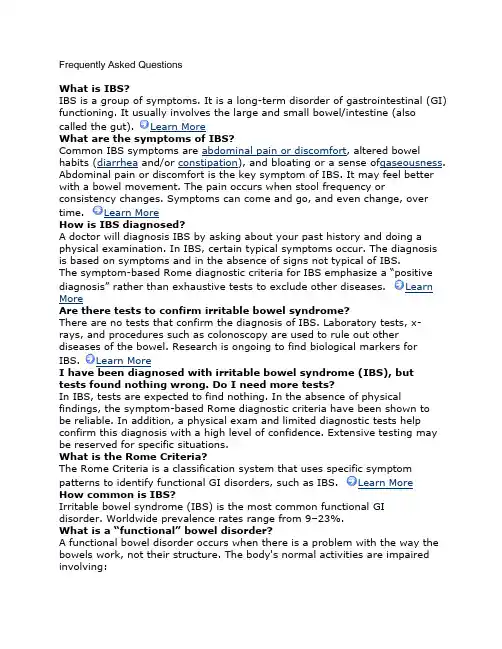
Frequently Asked QuestionsWhat is IBS?IBS is a group of symptoms. It is a long-term disorder of gastrointestinal (GI) functioning. It usually involves the large and small bowel/intestine (also called the gut). Learn MoreWhat are the symptoms of IBS?Common IBS symptoms are abdominal pain or discomfort, altered bowel habits (diarrhea and/or constipation), and bloating or a sense of gaseousness. Abdominal pain or discomfort is the key symptom of IBS. It may feel better with a bowel movement. The pain occurs when stool frequency or consistency changes. Symptoms can come and go, and even change, over time. Learn MoreHow is IBS diagnosed?A doctor will diagnosis IBS by asking about your past history and doing a physical examination. In IBS, certain typical symptoms occur. The diagnosis is based on symptoms and in the absence of signs not typical of IBS.The symptom-based Rome diagnostic criteria for IBS emphasize a “positive diagnosis” rather th an exhaustive tests to exclude other diseases. Learn MoreAre there tests to confirm irritable bowel syndrome?There are no tests that confirm the diagnosis of IBS. Laboratory tests, x-rays, and procedures such as colonoscopy are used to rule out other diseases of the bowel. Research is ongoing to find biological markers for IBS. Learn MoreI have been diagnosed with irritable bowel syndrome (IBS), buttests found nothing wrong. Do I need more tests?In IBS, tests are expected to find nothing. In the absence of physical findings, the symptom-based Rome diagnostic criteria have been shown tobe reliable. In addition, a physical exam and limited diagnostic tests help confirm this diagnosis with a high level of confidence. Extensive testing may be reserved for specific situations.What is the Rome Criteria?The Rome Criteria is a classification system that uses specific symptom patterns to identify functional GI disorders, such as IBS. Learn MoreHow common is IBS?Irritable bowel syndrome (IBS) is the most common functional GIdisorder. Worldwide prevalence rates range from 9–23%.What is a “functional” bowel disorder?A functional bowel disorder occurs when there is a problem with the way the bowels work, not their structure. The body's normal activities are impaired involving:• movement of the intestines,• sensitivity of the nerv es of the intestines, or• the way in which the brain controls some of these functions.What does “irritable” mean?Irritable means that the nerve endings in the bowel wall are unusually sensitive.What causes IBS?The cause of IBS is not yet completely understood. In IBS there is an altered pattern of muscle contraction in the colon. There is increased sensitivity within the GI tract. Normal regulation of the communication between the brain and the gut becomes altered. This leads to changes in normal bowel function.Does lactose intolerance cause IBS?Lactose (milk sugar) intolerance can cause similar symptoms to IBS. Lactose intolerance and IBS can occur at the same time in a person. But they are separate conditions which are treated differently. Learn MoreIs IBS a “serious illness”?For many people, IBS causes symptoms that are mild, which do not interfere with daily activities. For others, IBS may severely compromise their quality of life.Is IBS a risk factor for other serious disease?There are no long-term organic complications associated with IBS. People with IBS have no greater need of preventive checkups than other people. Will my IBS symptoms resolve?Each year, approximately 10% of IBS patients get better. This suggests that most people with IBS will eventually get better. But this is not true for every person.Can the menstrual cycle affect irritable bowel symptoms?Gut function does appear to be influenced by changes in the level of female hormones. Symptoms like looser stools and cramping can become worse at certain times of the cycle, particularly at the time of menses. It is reported as more intense in women with IBS, than in healthy women without IBS. Sometimes it's hard to tell whether it's coming from the pelvic organs or from the GI tract. Learn MoreWhat is the relationship of stress to IBS?Stress does not cause IBS. It can influence symptoms. Stress is the body’s normal response to stimuli, or stressors. It has been shown to increase motility and sensation of the colon to a greater degree in IBS patients compared to healthy individuals without IBS.Stress may modify signals between the brain and the intestinal tract. Factors that might normally affect the bowel might then affect it more. The stress factors could be physical, dietary, psychologic, or environmental. A personwith IBS might eat a regular meal and experience a bowel problem. For them, it's an overreaction of the bowel to the stressors. Learn More Doesn’t everyone experience stress in their life?Yes, and stressful events can cause a brief change in bowel habits and even abdominal pain for most people. However, this response in people with IBS is more pronounced on a recurrent or chronic basis.Does diet cause IBS?Diet does not cause IBS. Nevertheless, dietary factors may worsen symptoms in some persons. In IBS the bowel may over-react to stimuli. Even the act of eating, and not a particular food, may aggravate symptomsat times. Learn MoreDo certain foods affect symptoms?This varies from person to person. Certain foods are known to stimulate the gut in general, and in those with IBS eating too much of these might worsen symptoms. Maintaining a food and symptom diary for a minimum of one to two weeks can help identify triggering foods. Learn MoreMy doctor prescribed an antidepressant to treat my IBS. Does that mean I have a psychological disorder?In IBS low-dose antidepressants are useful, not to treat depression, but to reduce pain and also overall symptoms. Doses are much lower than what is used to treat depression. Learn MoreIs IBS a Disability?Depending on the circumstances it is up to each employer, insurer, or governing authority to determine individual disability.The U.S. Social Security Administration (SSA) defines disability as the inability to engage in any substantial gainful activity by reason of any medically determinable physical or mental impairment(s) which can be expected to result in death or which has lasted or can be expected to last for a continuous period of not less than 12 months. (SSA Pub. No. 64-039, May 2002) However, the SSA does not recognize irritable bowel syndrome on its Listing of Impairments -- Adults, Section 5, Digestive System.On August 15, 2011, the Department of Veterans Affairs (VA) implemented a “presumptive service connection” when assessing disability benefits in soldiers affected by functional GI disorders (such as IBS) who served in Southwest Asia during the Persian Gulf War.The Veterans Affairs Dept first recognized IBS in the Veterans Education and Benefits Expansion Act of 2001, Public Law 107-103 signed by President Bush on December 27, 2001. Section 202 -- Payment of Compensation for Persian Gulf War Veterans with Certain Chronic Disabilities -- includes this provision: (2) For purposes of this subsection, the term "qualifying chronic disability" means a chronic disability resulting from any of the following (or any combination of any of the following): (B) A medically unexplained chronic multi-symptom illness (such as chronic fatigue syndrome,fibromyalgia, and irritable bowel syndrome) that is defined by a cluster ofsigns or symptoms. The law authorizes funding to expand and increase educational, housing, burial and disability benefits for chronic multi-symptom illnesses to the list of service-connected conditions for Gulf War veterans.。
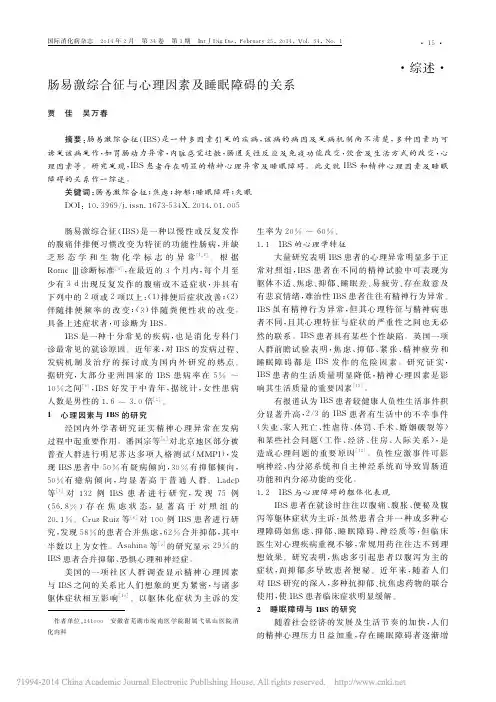
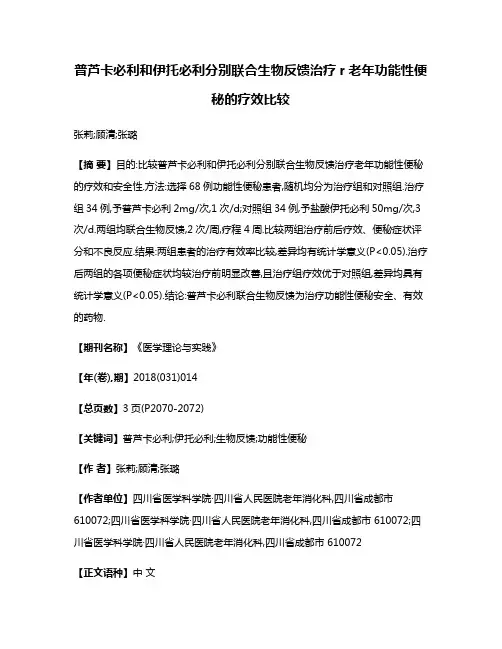
普芦卡必利和伊托必利分别联合生物反馈治疗r老年功能性便秘的疗效比较张莉;顾清;张璐【摘要】目的:比较普芦卡必利和伊托必利分别联合生物反馈治疗老年功能性便秘的疗效和安全性.方法:选择68例功能性便秘患者,随机均分为治疗组和对照组.治疗组34例,予普芦卡必利2mg/次,1次/d;对照组34例,予盐酸伊托必利50mg/次,3次/d.两组均联合生物反馈,2次/周,疗程4周.比较两组治疗前后疗效、便秘症状评分和不良反应.结果:两组患者的治疗有效率比较,差异均有统计学意义(P<0.05).治疗后两组的各项便秘症状均较治疗前明显改善,且治疗组疗效优于对照组,差异均具有统计学意义(P<0.05).结论:普芦卡必利联合生物反馈为治疗功能性便秘安全、有效的药物.【期刊名称】《医学理论与实践》【年(卷),期】2018(031)014【总页数】3页(P2070-2072)【关键词】普芦卡必利;伊托必利;生物反馈;功能性便秘【作者】张莉;顾清;张璐【作者单位】四川省医学科学院·四川省人民医院老年消化科,四川省成都市610072;四川省医学科学院·四川省人民医院老年消化科,四川省成都市 610072;四川省医学科学院·四川省人民医院老年消化科,四川省成都市 610072【正文语种】中文【中图分类】R574.62近年来,由于人们生活方式、饮食习惯及工作压力等多因素的影响慢性便秘的发病率呈逐年上升趋势[1],相关数据显示,成年人中便秘的患病率为16%,而老年人中患病率竟高达33.5%[2]。
研究还发现[3],年龄与功能性便秘的发病率呈正相关。
长期便秘由于其迁延反复难治的特点,不仅增加肛门直肠疾病、结肠肿瘤及心脑血管疾病的患病风险,还常伴随情绪失常及加重患者的经济负担,严重影响患者的身心健康[4]。
而对于功能性便秘,其病因复杂、常规治疗效果差、易依赖泻药且缺乏满意的治疗方案。
生物反馈疗法(Biofeedback therapy)为一种新兴生物行为疗法,目前已广泛应用于功能性便秘的临床治疗,具有无创、无痛、操作简单等优点[5]。
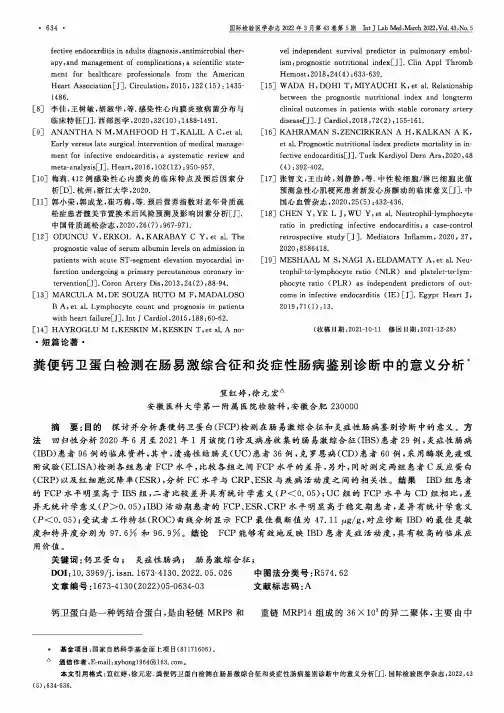
fective endocarditis in adults diagnosis,antimicrobial therapy,and management of complications:a scientific statement for healthcare professionals from the American Heart AssociationQj].Circulation,2015,132(15):1435-1486.[8]李佳,王树敏,胡淑华,等•感染性心内膜炎致病菌分布与临床特征[J].西部医学,2020,32(10):1488-1491.[9]ANANTHA N M,MAHFOOD H T,KALIL A C,et al.Early versus late surgical intervention of medical management for infective endocarditis:a systematic review and meta-analysis[J].Heart,2016,102(12):950-957.[10]梅莉.412例感染性心内膜炎的临床特点及预后因素分析[D].杭州:浙江大学,2020.口口郭小荣,郭成龙,崔巧梅,等.预后营养指数对老年骨质疏松症患者髓关节置换术后风险预测及影响因素分析[J1中国骨质疏松杂志,2020,26(7):967-971.[12]ODUNCU V,ERKOL A,KARABAY C Y,et al.Theprognostic value of serum albumin levels on admission in patients with acute ST-segment elevation myocardial infarction undergoing a primary percutaneous coronary in-tervention[J].Coron Artery Dis,2013,24(2):88-94.[13]MARCULA M,DE SOUZA BUTO M F,MADALOSOB A,et al.Lymphocyte count and prognosis in patientswith heart failure]J].Int J Cardiol,2015,188:60-62. [14]HAYROGLU M I,KESKIN M,KESKIN T,et al.A no-•短篇论著•vel independent survival predictor in pulmonary embolism:prognostic nutritional index]J].Clin Appl Thromb Hemost,2018,24(4)-633-639.[15]WADA H,DOHI T,MIYAUCHI K,et al.Relationshipbetween the prognostic nutritional index and longterm clinical outcomes in patients with stable coronary artery disease^].J Cardiol,2018,72(2):155-161.[16]KAHRAMAN S,ZENCIRKRAN A H,KALKAN A K,et al.Prognostic nutritional index predicts mortality in infective endocarditisQJ].Turk Kardiyol Dern Ars,2020,48(4):392-402.[17]张智文,王山岭,刘静静,等.中性粒细胞/淋巴细胞比值预测急性心肌梗死患者新发心房颤动的临床意义[J1中国心血管杂志,2020,25(5):432-436.[18]CHEN Y,YE L J,WU Y,et al.Neutrophil-lymphocyteratio in predicting infective endocarditis:a case-control retrospective study[J].Mediators Inflamm,2020,27, 2020:858641&[19]MESHAAL M S,NAGI A,ELDAMATY A,et al.Neutrophil-to-lymphocyte ratio(NLR)and platelet-to-lym-phocyte ratio(PLR)as independent predictors of outcome in infective endocarditis(IE)[J].Egypt Heart J, 2019,71(1):13.(收稿日期=2021-10-11修回日期-2021-12-28)粪便钙卫蛋白检测在肠易激综合征和炎症性肠病鉴别诊断中的意义分析負红婷,徐元宏公安徽医科大学第一附属医院检验科,安徽合肥230000摘要:目的探讨并分析粪便钙卫蛋白(FCP)检测在肠易激综合征和炎症性肠病鉴别诊断中的意义。
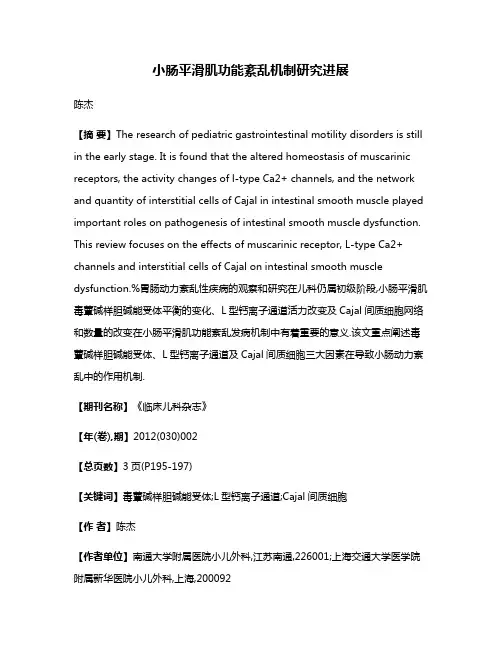
小肠平滑肌功能紊乱机制研究进展陈杰【摘要】The research of pediatric gastrointestinal motility disorders is still in the early stage. It is found that the altered homeostasis of muscarinic receptors, the activity changes of l-type Ca2+ channels, and the network and quantity of interstitial cells of Cajal in intestinal smooth muscle played important roles on pathogenesis of intestinal smooth muscle dysfunction. This review focuses on the effects of muscarinic receptor, L-type Ca2+ channels and interstitial cells of Cajal on intestinal smooth muscle dysfunction.%胃肠动力紊乱性疾病的观察和研究在儿科仍属初级阶段,小肠平滑肌毒蕈碱样胆碱能受体平衡的变化、L型钙离子通道活力改变及Cajal间质细胞网络和数量的改变在小肠平滑肌功能紊乱发病机制中有着重要的意义.该文重点阐述毒蕈碱样胆碱能受体、L型钙离子通道及Cajal间质细胞三大因素在导致小肠动力紊乱中的作用机制.【期刊名称】《临床儿科杂志》【年(卷),期】2012(030)002【总页数】3页(P195-197)【关键词】毒蕈碱样胆碱能受体;L型钙离子通道;Cajal间质细胞【作者】陈杰【作者单位】南通大学附属医院小儿外科,江苏南通,226001;上海交通大学医学院附属新华医院小儿外科,上海,200092【正文语种】中文【中图分类】R725胃肠动力紊乱性疾病(disorders of gastrointestinal motility,DGIM)的诊断以运动检测指标为基础,其运动障碍可以是胃肠本身的功能异常,也可能是其他系统疾病的结果。
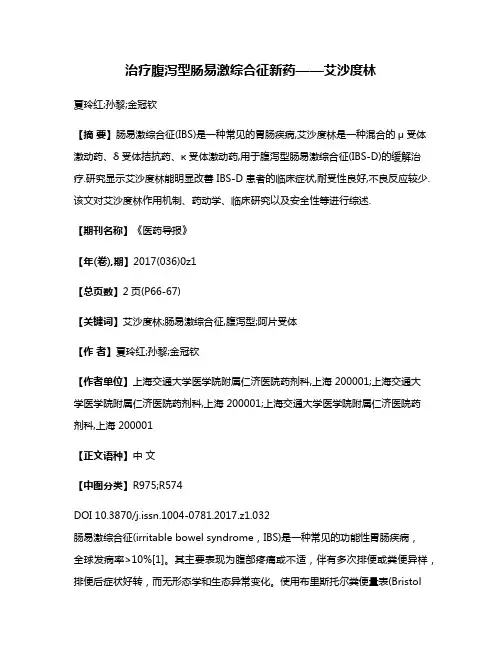
治疗腹泻型肠易激综合征新药——艾沙度林夏玲红;孙黎;金冠钦【摘要】肠易激综合征(IBS)是一种常见的胃肠疾病,艾沙度林是一种混合的μ受体激动药、δ受体拮抗药、κ受体激动药,用于腹泻型肠易激综合征(IBS-D)的缓解治疗.研究显示艾沙度林能明显改善IBS-D患者的临床症状,耐受性良好,不良反应较少.该文对艾沙度林作用机制、药动学、临床研究以及安全性等进行综述.【期刊名称】《医药导报》【年(卷),期】2017(036)0z1【总页数】2页(P66-67)【关键词】艾沙度林;肠易激综合征,腹泻型;阿片受体【作者】夏玲红;孙黎;金冠钦【作者单位】上海交通大学医学院附属仁济医院药剂科,上海 200001;上海交通大学医学院附属仁济医院药剂科,上海 200001;上海交通大学医学院附属仁济医院药剂科,上海 200001【正文语种】中文【中图分类】R975;R574DOI 10.3870/j.issn.1004-0781.2017.z1.032肠易激综合征(irritable bowel syndrome,IBS)是一种常见的功能性胃肠疾病,全球发病率>10%[1]。
其主要表现为腹部疼痛或不适,伴有多次排便或粪便异样,排便后症状好转,而无形态学和生态异常变化。
使用布里斯托尔粪便量表(BristolStool Form Scale,BSFS),IBS患者可分为腹泻型、便秘型、腹泻便秘交替型和不确定型[2]。
其中以腹泻型IBS(IBS-D)最为常见,约占40%。
美国食品药品管理局(FDA)于2015年5月批准艾沙度林(eluxadoline)用于腹泻型IBS的缓解治疗,推荐剂量为100 mg,每天2次,与食物同服。
艾沙度林具有混合的阿片受体活性——μ受体激动药、δ受体拮抗药及κ受体激动药[3]。
阿片受体在体内广泛分布,一般可分为4种亚型,包括μ受体κ受体、δ受体及阿片样受体-1[4]。
艾沙度林具有混合的阿片受体活性,激动μ受体,可以缓解腹泻型IBS患者肠道疼痛症状,同时减慢胃肠蠕动,从而改善腹泻。
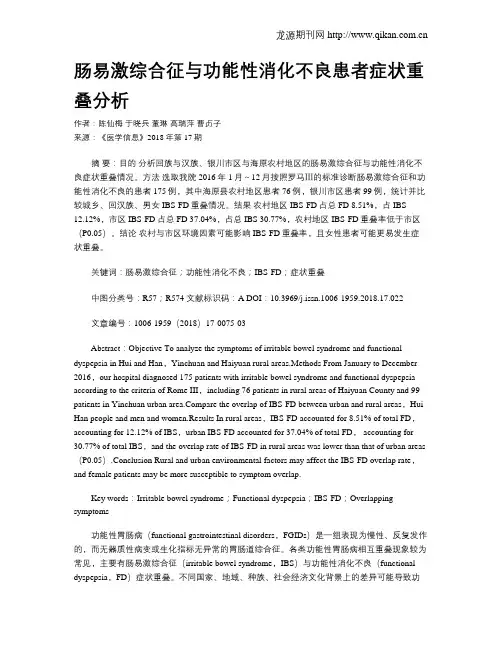
肠易激综合征与功能性消化不良患者症状重叠分析作者:陈仙梅于晓兵董琳高瑞萍曹贞子来源:《医学信息》2018年第17期摘要:目的分析回族与汉族、银川市区与海原农村地区的肠易激综合征与功能性消化不良症状重叠情况。
方法选取我院2016年1月~12月按照罗马Ⅲ的标准诊断肠易激综合征和功能性消化不良的患者175例,其中海原县农村地区患者76例,银川市区患者99例,统计并比较城乡、回汉族、男女IBS-FD重叠情况。
结果农村地区IBS-FD占总FD 8.51%,占IBS 12.12%,市区IBS-FD占总FD 37.04%,占总IBS 30.77%,农村地区IBS-FD重叠率低于市区(P0.05)。
结论农村与市区环境因素可能影响IBS-FD重叠率,且女性患者可能更易发生症状重叠。
关键词:肠易激综合征;功能性消化不良;IBS-FD;症状重叠中图分类号:R57;R574 文献标识码:A DOI:10.3969/j.issn.1006-1959.2018.17.022文章编号:1006-1959(2018)17-0075-03Abstract:Objective To analyze the symptoms of irritable bowel syndrome and functional dyspepsia in Hui and Han,Yinchuan and Haiyuan rural areas.Methods From January to December 2016,our hospital diagnosed 175 patients with irritable bowel syndrome and functional dyspepsia according to the criteria of Rome III,including 76 patients in rural areas of Haiyuan County and 99 patients in Yinchuan urban pare the overlap of IBS-FD between urban and rural areas,Hui Han people and men and women.Results In rural areas,IBS-FD accounted for 8.51% of total FD,accounting for 12.12% of IBS,urban IBS-FD accounted for 37.04% of total FD, accounting for 30.77% of total IBS,and the overlap rate of IBS-FD in rural areas was lower than that of urban areas (P0.05).Conclusion Rural and urban environmental factors may affect the IBS-FD overlap rate,and female patients may be more susceptible to symptom overlap.Key words:Irritable bowel syndrome;Functional dyspepsia;IBS-FD;Overlapping symptoms功能性胃肠病(functional gastrointestinal disorders,FGIDs)是一组表现为慢性、反复发作的,而无器质性病变或生化指标无异常的胃肠道综合征。
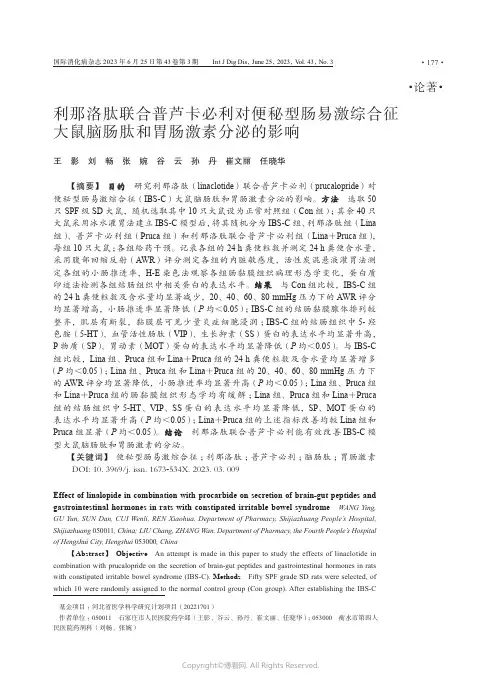
·论著·利那洛肽联合普芦卡必利对便秘型肠易激综合征大鼠脑肠肽和胃肠激素分泌的影响王影刘畅张婉谷云孙丹崔文丽任晓华【摘要】目的研究利那洛肽(linaclotide)联合普芦卡必利(prucalopride)对便秘型肠易激综合征(IBS-C)大鼠脑肠肽和胃肠激素分泌的影响。
方法选取50只 SPF级SD大鼠,随机选取其中10只大鼠设为正常对照组(Con组);其余40只大鼠采用冰水灌胃法建立IBS-C模型后,将其随机分为IBS-C组、利那洛肽组(Lina组)、普芦卡必利组(Pruca组)和利那洛肽联合普芦卡必利组(Lina+Pruca组),每组10只大鼠;各组给药干预。
记录各组的24 h粪便粒数并测定24 h粪便含水量,采用腹部回缩反射(AWR)评分测定各组的内脏敏感度,活性炭混悬液灌胃法测定各组的小肠推进率,H-E染色法观察各组肠黏膜组织病理形态学变化,蛋白质印迹法检测各组结肠组织中相关蛋白的表达水平。
结果与Con组比较,IBS-C组的24 h粪便粒数及含水量均显著减少,20、40、60、80 mmHg压力下的AWR评分均显著增高,小肠推进率显著降低(P均<0.05);IBS-C组的结肠黏膜腺体排列较整齐,肌层有断裂,黏膜层可见少量炎症细胞浸润;IBS-C组的结肠组织中5-羟色胺(5-HT)、血管活性肠肽(VIP)、生长抑素(SS)蛋白的表达水平均显著升高,P物质(SP)、胃动素(MOT)蛋白的表达水平均显著降低(P均<0.05)。
与IBS-C组比较,Lina组、Pruca组和Lina+Pruca组的24 h粪便粒数及含水量均显著增多(P均<0.05);Lina组、Pruca组和Lina+Pruca组的20、40、60、80 mmHg压力下的AWR评分均显著降低,小肠推进率均显著升高(P均<0.05);Lina组、Pruca组和Lina+Pruca组的肠黏膜组织形态学均有缓解;Lina组、Pruca组和Lina+Pruca组的结肠组织中5-HT、VIP、SS蛋白的表达水平均显著降低,SP、MOT蛋白的表达水平均显著升高(P均<0.05);Lina+Pruca组的上述指标改善均较Lina组和Pruca组显著(P均<0.05)。
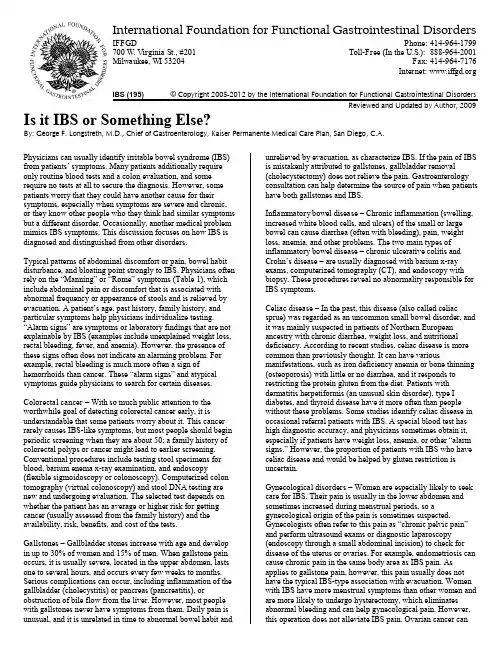
International Foundation for Functional Gastrointestinal DisordersIFFGD700 W. Virginia St., #201 Milwaukee, WI 53204Phone: 414-964-1799Toll-Free (In the U.S.): 888-964-2001Fax: 414-964-7176 Internet: IBS (195)© Copyright 2005-2012 by the International Foundation for Functional Gastrointestinal DisordersReviewed and Updated by Author, 2009Is it IBS or Something Else?By: George F. Longstreth, M.D., Chief of Gastroenterology, Kaiser Permanente Medical Care Plan, San Diego, C.A.Physicians can usually identify irritable bowel syndrome (IBS) from patients’ symptoms. Many patients additionally require only routine blood tests and a colon evaluation, and some require no tests at all to secure the diagnosis. However, some patients worry that they could have another cause for their symptoms, especially when symptoms are severe and chronic, or they know other people who they think had similar symptoms but a different disorder. Occasionally, another medical problem mimics IBS symptoms. This discussion focuses on how IBS is diagnosed and distinguished from other disorders.Typical patterns of abdominal discomfort or pain, bowel habit disturbance, and bloating point strongly to IBS. Physicians often rely on the “Manning” or “Rome” symptoms (Table 1), which include abdominal pain or discomfort that is associated with abnormal frequency or appearance of stools and is relieved by evacuation. A patient’s age, past history, family history, and particular symptoms help physicians individualize testing.“Alarm signs” are symptoms or laboratory findings that are not explainable by IBS (examples include unexplained weight loss, rectal bleeding, fever, and anemia). However, the presence of these signs often does not indicate an alarming problem. For example, rectal bleeding is much more often a sign ofhemorrhoids than cancer. These “alarm signs” and atypical symptoms guide physicians to search for certain diseases.Colorectal cancer – With so much public attention to the worthwhile goal of detecting colorectal cancer early, it is understandable that some patients worry about it. This cancer rarely causes IBS-like symptoms, but most people should begin periodic screening when they are about 50; a family history of colorectal polyps or cancer might lead to earlier screening. Conventional procedures include testing stool specimens for blood, barium enema x-ray examination, and endoscopy(flexible sigmoidoscopy or colonoscopy). Computerized colon tomography (virtual colonoscopy) and stool DNA testing are new and undergoing evaluation. The selected test depends on whether the patient has an average or higher risk for getting cancer (usually assessed from the family history) and the availability, risk, benefits, and cost of the tests.Gallstones – Gallbladder stones increase with age and develop in up to 30% of women and 15% of men. When gallstone pain occurs, it is usually severe, located in the upper abdomen, lasts one to several hours, and occurs every few weeks to months. Serious complications can occur, including inflammation of the gallbladder (cholecystitis) or pancreas (pancreatitis), orobstruction of bile flow from the liver. However, most people with gallstones never have symptoms from them. Daily pain is unusual, and it is unrelated in time to abnormal bowel habit and unrelieved by evacuation, as characterize IBS. If the pain of IBS is mistakenly attributed to gallstones, gallbladder removal (cholecystectomy) does not relieve the pain. Gastroenterology consultation can help determine the source of pain when patients have both gallstones and IBS.Inflammatory bowel disease – Chronic inflammation (swelling, increased white blood cells, and ulcers) of the small or large bowel can cause diarrhea (often with bleeding), pain, weight loss, anemia, and other problems. The two main types of inflammatory bowel disease – chronic ulcerative colitis and Crohn’s disease – are usually diagnosed with barium x-ray exams, computerized tomography (CT), and endoscopy with biopsy. These procedures reveal no abnormality responsible for IBS symptoms.Celiac disease – In the past, this disease (also called celiacsprue) was regarded as an uncommon small bowel disorder, and it was mainly suspected in patients of Northern European ancestry with chronic diarrhea, weight loss, and nutritional deficiency. According to recent studies, celiac disease is more common than previously thought. It can have variousmanifestations, such as iron deficiency anemia or bone thinning (osteoporosis) with little or no diarrhea, and it responds to restricting the protein gluten from the diet. Patients with dermatitis herpetiformis (an unusual skin disorder), type I diabetes, and thyroid disease have it more often than people without these problems. Some studies identify celiac disease in occasional referral patients with IBS. A special blood test has high diagnostic accuracy, and physicians sometimes obtain it, especially if patients have weight loss, anemia, or other “alarm signs.” However, the proportion of patients with IBS who have celiac disease and would be helped by gluten restriction is uncertain.Gynecological disorders – Women are especially likely to seek care for IBS. Their pain is usually in the lower abdomen and sometimes increased during menstrual periods, so a gynecological origin of the pain is sometimes suspected.Gynecologists often refer to this pain as “chronic pelvic pain” and perform ultrasound exams or diagnostic laparoscopy (endoscopy through a small abdominal incision) to check for disease of the uterus or ovaries. For example, endometriosis can cause chronic pain in the same body area as IBS pain. As applies to gallstone pain, however, this pain usually does not have the typical IBS-type association with evacuation. Women with IBS have more menstrual symptoms than other women and are more likely to undergo hysterectomy, which eliminates abnormal bleeding and can help gynecological pain. However, this operation does not alleviate IBS pain. Ovarian cancer can。

腹泻型肠易激综合征相关的菌-肠-脑轴机制研究进展摘要:腹泻型肠易激综合征(IBS-D) 是临床上常见的功能性肠病之一,病因和发病机制多样,目前尚未有明确的定论。
有相关研究证明肠道菌群失调是IBS-D 的重要发病原因之一,最新罗马Ⅳ标准指出脑-肠互动障碍可能贯穿肠易激综合征( IBS) 发病的始终。
肠道微生态失衡被认为是导致脑-肠互动障碍的重要始动因素,参与构成菌群-肠-脑轴,成为新兴研究热点。
本文以菌-脑-肠轴机制为出发点,探讨总结其与 IBS-D 的联系及研究进展,为进一步探究 IBS-D 的发病机制提供更有价值的参考依据。
关键词:腹泻型肠易激综合征;肠道菌群;菌-肠-脑轴;研究进展中图分类号:R 文献标识码:AProgress In the Research of the Microbiota-Gut-Brain Axis About Diarrhea TypeIrritable Bowel SyndromeDeng Tianlin1, Yang Linlin1,Feng Peimin2△(1. Chengdu University of Traditional Chinese Medicine, Chengdu Sichuan, 610075, China)(2. Department of gastroenterology, Affiliated Hospital of ChengduUniversity of Traditional Chinese Medicine, Chengdu Sichuan, 610072, China) Abstract: Diarrhea-predominant irritable bowel syndrome(IBS-D)is one of the common functional gastrointestinal diseases in clinical practice. Its aetiology and pathogenesis is perse. There is no clear conclusion. Studies have shown that intestinal dysbacteriosis is an important cause of IBS-D. The latest Rome IV criteria states that abnormal brain-gut interaction may persist throughout the onset of irritable bowel syndrome (IBS).Intestinal dysbiosis is considered to be an important initiating factor leading to disorder of brain-gut interaction, constituting the microbiota-gut-brain axis, which has become a new research hotspot. This paper takes the mechanism of microbiota-gut-brain axis as the starting point, discusses its relationship with IBS-D and its research progress, and provides a more valuable reference for further exploring thepathogenesis of IBS-D.Keywords: Diarrhea Type Irritable Bowel Syndrome;Intestinal Microbiota;Microbiota-Gut-Brain Axis;Research Progress前言肠易激综合征(irritable bowel syndrome,IBS)是一组表现为反复发作的腹痛症状并伴有排便习惯和粪便性状改变的功能性肠道疾病,然而临床上尚无可观察的形态学及生化学的改变。
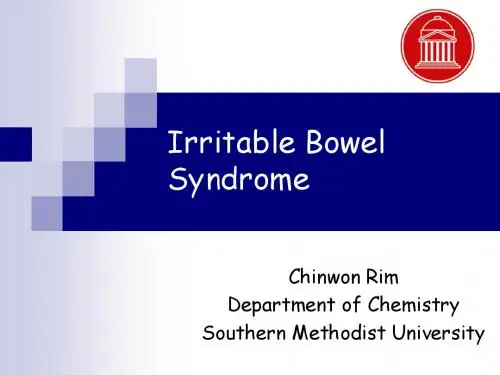
O RIGINAL CONTRIBUTIONS nature publishing group848F U N C T I O N A LG I D I S O R D E R SI NTRODUCTION Irritable bowel syndrome (IBS) is a chronic disorder of gastroin-testinal function that is characterized by recurrent abdominal pain and altered bowel habits in the absence of detectable organic dis-ease ( 1 ). Although IBS is extremely prevalent, aff ecting up to 15 % of the general adult population ( 2 ), diagnosing IBS is not always straightforward. Properly diagnosing IBS can be challenging and uncertain for several reasons, including: (i) there is currently no consistent biological marker of IBS, leaving clinicians to rely onpatient symptoms alone to make the diagnosis; (ii) the symptoms of IBS are oft en diffi cult to quantify objectively; (iii) symptoms can vary among individuals with IBS, and (iv) many organic conditions can masquerade as IBS ( 3 ). Th e last fact is the most troubling to clinicians and patients, many of whom remain unsettled by the prospect of overlooking alternative diagnoses such as infl amma-tory bowel disease, microscopic colitis, infectious colitis, small intestinal bacterial overgrowth, celiac sprue, gluten sensitivity, and colon neoplasia, among many others. Th is uncertainty oft enI s Irritable Bowel Syndrome a Diagnosis of Exclusion?: A Survey of Primary Care Providers, Gastroenterologists, and IBS ExpertsB rennan M.R. S piegel , M D , M SHS 1 – 6 , M ary F arid , M D 1 , 2 , E ric E srailian , M D , M PH 2 , 6 , J ennifer T alley , M SPH 1 , 5 and L inC hang , MD 1 , 2 , 5 , 6O BJECTIVES: Guidelines emphasize that irritable bowel syndrome (IBS) is not a diagnosis of exclusion and en-courage clinicians to make a positive diagnosis using the Rome criteria alone. Yet many clinicians are concerned about overlooking alternative diagnoses. We measured beliefs about whether IBS is a diagnosis of exclusion, and measured testing proclivity between IBS experts and community providers.M ETHODS: We developed a survey to measure decision-making in two standardized patients with Rome III-positive IBS, including IBS with diarrhea (D-IBS) and IBS with constipation (C-IBS). The survey elicited provider knowledge and beliefs about IBS, including testing proclivity and beliefs regarding IBS as a diagnosis of exclusion. We surveyed nurse practitioners, primary care physicians, community gastroenterologists, and IBS experts.R ESULTS: E xperts were less likely than nonexperts to endorse IBS as a diagnosis of exclusion (8 vs. 72 % ; P < 0.0001). In the D-IBS vignette, experts were more likely to make a positive diagnosis of IBS (67 vs. 38 % ; P < 0.001), to perform fewer tests (2.0 vs. 4.1; P < 0.01), and to expend less money on testing (US $ 297 vs. $ 658; P < 0.01). Providers who believed IBS is a diagnosis of exclusion ordered 1.6 more tests and consumed $ 364 more than others ( P < 0.0001). Experts only rated celiac sprue screening and complete blood count as appropriate in D-IBS; nonexperts rated most tests as appropriate. Parallel results were found in the C-IBS vignette.C ONCLUSIONS: M ost community providers believe IBS is a diagnosis of exclusion; this belief is associated withincreased resource use. Experts comply more closely with guidelines to diagnose IBS with minimal testing. This disconnect suggests that better implementation of guidelines is warranted to minimize variation and improve cost-effectiveness of care.A m J Gastroenterol 2010; 105:848–858; d oi: 10.1038/ajg.2010.47; published online 2 March 2010 1D epartment of Gastroenterology, VA Greater Los Angeles Healthcare System , L os Angeles , C alifornia , U SA ; 2D ivision of Digestive Diseases, David Geffen School ofMedicine at UCLA , L os Angeles , C alifornia , U SA ; 3 D epartment of Health Services, UCLA School of Public Health , L os Angeles , C alifornia , U SA ; 4C URE DigestiveDiseases Research Center , L os Angeles , C alifornia , U SA ; 5C enter for Neurobiology of Stress, David Geffen School of Medicine at UCLA , L os Angeles , C alifornia ,U SA ; 6U CLA / V A Center for Outcomes Research and Education , L os Angeles , C alifornia , U SA . C orrespondence: B rennan M.R. Spiegel, MD, MSHS , D epartment of Gastroenterology, VA Greater Los Angeles Healthcare System, 11301 Wilshire Boulevard , Building 115, Room 215, L os Angeles , C alifornia 90073 , U SA . E-mail: b spiegel@R eceived 29 October 2009; accepted 5 January 2010849F U N C T I O N A LG I D I S O R D E R S I BS: A Diagnosis of Exclusion? prompts a series of diagnostic tests to exclude alternative etiolo-gies. In other words, many clinicians approach IBS as a diagnosisof exclusion.D espite the tendency of clinicians to order diagnostic tests in the face of IBS symptoms, the Rome III criteria encourage clini-cians to make a positive diagnosis on the basis of symptom cri-teria derived from the previously validated Manning and Kruis criteria, and emphasize that IBS is not a diagnosis of exclusion despite its broad diff erential diagnosis ( 1 ). Th is recommendation is based on evidence that diagnostic testing has a generally low yield in patients fulfi lling the Rome criteria who otherwise lack alarming features ( 4,5 ). A decade ago Vanner e t al.( 6)showed that Rome I-positive symptoms have a positive predictive value of 98 %for IBS. Th at is, using diagnostic testing strategies at the time, 98 % of Rome-positive patients ended up having IBS, and did not have an underlying organic condition aft er undergoing standard evaluations. Th e previous Rome II guidelines stated that IBS can be diagnosed so long as “ t here are no structural or biochemical abnormalities, ” whereas the current Rome III guidelines maintain that IBS can be diagnosed in the absence of “ a larm features, ” and is “ o ft en prop-erly diagnosed without testing ” ( 1 ). But these clinical asterisks are understandably diffi cult for many providers to recon c ile, and some argue that they raise more questions than they answer. Questions like: What diagnostic tests, if any, should be performed before clini-cians can reliably diagnose IBS? Is it really possible to make the diag-nosis without any information from diagnostic testing? Or should a complete blood count, chemistry panel, and stool occult blood test, at the very least, be drawn in all potential IBS patients? What about testing for celiac sprue, gluten sensitivity, or colon cancer?T o better understand current diagnostic decision-making in IBS, we performed a vignette survey to measure provider beliefs about whether IBS is a diagnosis of exclusion, and to measure beliefs about the appropriateness of commonly available diag-nostic tests in IBS. We hypothesized that providers who believe IBS is a diagnosis of exclusion conduct more diagnostic tests and expend more resources in evaluating patients with IBS symptoms compared with providers who do not share this belief. We further hypothesized that provider beliefs regarding diagnostic testing in IBS exhibit extreme variation beyond chance alone and diverge from published guidelines.M ETHODSV ignette survey design We developed an online vignette-based questionnaire to evaluate decision-making in two standardized patients with bowel symp-toms that met Rome III criteria for IBS: one patient met criteria for IBS with diarrhea (D-IBS), the other for IBS with constipation (C-IBS). We developed the vignettes in concert with IBS experts and survey design specialists to ensure clinical face validity, com-prehensibility, and comprehensiveness — a process we have pre-viously followed in other vignette surveys ( 7 – 10 ). Th e vignettes began with a patient history and physical examination, and were followed by management questions pertaining to diagnostic test-ing, treatment, and follow-up. Th e questions included verticalsingle best answers, horizontal matrix items, and open-ended items. Th e D-IBS vignette described a 42-year-old woman with longstanding frequent, loose stools, lower abdominal cramping that improved with stool passage, and no evidence of alarming signs or symptoms. Th e C-IBS vignette described a 52-year-old woman with longstanding intermittent lower abdominal pain and constipation with bloating, hard stools, straining, and a sense of incomplete evacuation aft er defecation. Both patients met Rome III criteria for IBS, lacked alarm features, were not receiv-ing medications known to cause IBS symptoms, and had no fam-ily history of gastrointestinal malignancy or infl ammatory bowel disease. Th e full vignettes are presented in the A ppendix A .Th e vignettes were accompanied by a series of stand-alone questions pertaining to IBS etiology and clinical decision-making, includ-ing beliefs about the etiology of IBS, belief about whether IBS is a diagnosis of exclusion, and knowledge about the yield of com-mon diag n ostic tests, as described further, below. Respondents received $ 10 for completing the survey. Th e study was approved by the Veteran Administration Greater Los Angeles Institutional Review Board and was conducted in accordance with the institu-tional guidelines regulating human subject research.S ampling frame W e surveyed four provider groups:S ample of IBS key opinion leaders ( “ e xperts ” ).We surveyed 50in-ternational gastroenterologists (GIs) who are recognized experts in IBS. We identifi ed these experts based on publication records over the past 10 years, membership in practice guideline com-mittees including the Rome Foundation Working Groups, and participation in advisory councils for the American College of Gastroenterology and the American Gastroenterological Asso-ciation. We use the term “ e xpert ” in reference to this group throughout the remainder of this paper. S imple random sample of community gastroenterologists . W e surveyed a random sample of 300 GIs from the membership di-rectory of the American Gastroenterological Association. In case the random selection process identifi ed an IBS expert already i ncluded in the fi rst group of providers, we repeated the selec-tion process to identify a second individual to avoid duplicates be-tween samples. We used a random number generator to identify subjects in this and other groups, below. S imple random sample of general internal medicine physicians .W e surveyed a random sample of 300 general internal medicine physicians (GIMs), including internists and family practitioners, from the membership directory of the American Medical Association.S imple random sample of nurse practitioners .T o include a con-trol group of nonphysicians who regularly manage IBS, we sought a group of nurse practitioners (NPs) working in primary care. We surveyed a random sample of 300 NPs from the National Veteran Aff airs provider database.850F U N C T I O N A LG I D I S O R D E R S S piegel e t al.S urvey sample size, distribution, and follow-up procedures Assuming 15 subjects for each of 10 potential independent predic-tors in multivariable regression analysis (see “ A nalyses ” section), we required a minimum of 150 subjects to complete the survey to avoid overmatching of the regression models. Respondents initially received the survey electronically using an online questionnaire platform (Survey Monkey soft ware, w ). Physicians received e-mails with cover letters and a link to the online survey. Aft er 2 weeks, nonresponders received a follow-up e-mail. Finally, 1 week aft er the second e-mail correspondence, a paper version of the questionnaire was mailed to nonresponders.A nalyses M easuring variations in diagnostic decision-making . W e mea-sured the level of agreement among provider groups for endorse-ment of commonly available diagnostic tests for D-IBS symptoms. Following the patient history and physical examination, and in the absence of additional diagnostic testing information, respondents were asked the following question: “B ased upon the information provided to this point, do you believe that this patient has irritable bowel syndrome? ” Respondents selected between three options: “Y es,”“N o,”and “U nsure —n eed more information,”Th ose who believed the patient has IBS were asked a follow-up question to explore their willingness to inform the patient of the presumed diagnosis: “ I n addition to believing that this patient has IBS, are you also prepared at this time to confi dently and affi rmatively inform her that she has IBS? ” Respondents selected between three options: “ Y es — I am prepared to make a confi dent and affi rmative diagnosis and inform the patient; ” “ N o — I need more information before making a confi dent and affi rmative diagnosis; ”or “N o —I am confi dent of the diagnosis, but I am not yet prepared to inform the patient.”R espondents were then asked to rate the appropriateness of a range of laboratory, radiographic, and endoscopic tests using a standard nine-point RAND / U CLA Appropriateness Scale (RAS) with the following interpretation: scores 1 –3=“g enerally inappro-priate; ”4 –6=“n either inappropriate nor appropriate; ”7 –9=“g en-erally appropriate ” ( 11 ). We compared mean RAS scores among provider groups using analysis of variance and a P value <0.05 as signifi cant. To quantify the level of agreement, we also calculated the RAND /U CLA “D isagreement Index ”(D I) for each factor ( 11 ). Th e DI is based on the distribution and symmetry of the scores across the nine-point RAS, and has been externally validated as a measure of variation in provider beliefs and previously used in gastroenterology provider surveys ( 7 – 9 ). A higher D I indicates wider spread across the nine-point scale, and lower values indicate increasing consensus. If the DI exceeds 1.0, then the distribution meets criteria for “ e xtreme variation ” in ratings — m ore than what would be expected by chance alone. If the DI is ≤ 1.0, then there is not extreme variation. Th e D I is calculated using a standard published equation ( 11 ).M easuring diagnostic costs .W e measured the diagnostic costs of care endorsed by each respondent in their work-up of the stand-ardized patients. To measure this outcome, we fi rst itemized thetotal number of diagnostic tests endorsed by each respondent, andthen assigned a cost to each diagnostic test based on a third-party payer perspective. We obtained costs for physician services and endoscopic, radiographic, and surgical procedures from the 2008 American Medical Association Current Procedural Terminology codebook and the 2008 Medicare Fee Schedule. We then derived aggregate costs per respondent by tabulating the number and type of tests performed, and then summing the assigned costs for the tests. We compared aggregate costs expended between provider groups using analysis of variance, and also measured diff erences between expert and nonexpert groups using a t -test. We then performed multivariate regression analysis to determine if any provider or practice-type characteristics (e.g., provider age, gender, practice setting, years of practice, provider type, percent of time dedicated to clinical care, research experience, number of patients with IBS evaluated per month) were associated with over-all diagnostic testing expenditures.B elief about IBS as a diagnosis of exclusion .W e posed a stand-alone question separate from the clinical vignette, as follows: “ B ased on your clinical experience, do you believe that IBS is primarily a diagnosis of exclusion (i.e. one or more diagnostic tests should be performed before diagnosing IBS)? ”Respondents selected between two options: (i) “ Y es — I BS is primarily a diag-nosis of exclusion; and, ” or (ii) “ N o — I BS is not primarily a diag-nosis of exclusion. ” We fi rst calculated the proportion of respond-ents in each provider group who endorsed IBS as a diagnosis of exclusion, and then compared proportions among groups usinga χ 2-test. We then performed multivariable regression analysis to evaluate the impact of this belief on diagnostic testing outcomes, including the total number of tests endorsed and the total expenses incurred in diagnostic testing. We hypothesized that respondents who endorsed IBS as a diagnosis of exclusion would order more tests and incur higher diagnostic costs than respondents who did not endorse this belief, independent of other factors. K nowledge about yield of common diagnostic tests in IBS . D ata indicate that the yield of common diagnostic tests in IBS, inclu-ding colonoscopy, stool studies, infl ammatory markers, and thyroid function testing, among others, is low ( 5,12 ). It is possible that some providers overestimate the diagnostic yield of common diagnostic tests in IBS, and that knowledge about test yield may provide diagnostic decision-making. We therefore posed a series of questions to assess knowledge and experience with diagnostic test-ing yield in IBS. Respondents viewed a list of common diag n ostic tests beneath the following instructions: “ B ased on your clinical experience with patients similar to this woman, what percentage of the time do each of the following tests identify a treatable cause for the bowel symptoms (please provide your best estimate). ” For each diagnostic test, respondents selected between three estimates of diagnostic yield: (1) < 1 % of the time; (2) 1 – 10 % of the time; and (3) > 10 % of the time. In each case current published data indicate yield rates of 10 % or less ( 5 ), suggesting that the optimal evidence-based response for each item was either 1 or 2, but not 3. We operationalized provider diagnostic testing knowledge with851F U N C T I O N A LG I D I S O R D E R S I BS: A Diagnosis of Exclusion? a “ k nowledge index, ” which was a composite score representing the proportion of nine diagnostic test yield questions answered correctly by each respondent — a technique we have used in previous vignette surveys ( 7,9 ). We compared mean scores among provider groups, and evaluated the bivariate and multivariate relationship between testing knowledge and diagnostic resource use outcomes. We hypothesized that less knowledge about test yield would be associated with higher diagnostic resource use.R ESULTSS ample characteristicsT able 1 shows the characteristics of the survey respondents. A total of 308 respondents returned their surveys, including 27 of 50 IBS experts (54 % response rate), 90 of 300 community GIs (30 % response), 89 of 300 GIMs (30 % response), and 102 of 300 NPs (34 % response). Using data from the American Medical Associa-tion Masterfi le, we found no diff erence between responder and nonresponders for age, gender, or years in practice. Th e expert group was signifi cantly more likely to be engaged in conducting research and evaluated more IBS patients per month. However, compared with the nonexpert groups, experts had a smaller pro-portion of time dedicated to clinical care.D iagnostic decision-making in D-IBSF igure 1 shows the data regarding willingness to diagnose IBS in the D-IBS vignette. Seventy percent of the IBS experts believed the patient had IBS based on review of the history and physi-cal examination alone, of whom 53 % were prepared to confi -dently and affi rmatively inform the patient that they have IBS. Th e remaining IBS experts requested additional information, described further below. Among community GIs, GIMs, and NPs, the percentages who believed the patient had IBS were 52, 34,and 41%,respectively (P <0.01).Overall,IBS experts were signifi cantly more likely to believe the patient had IBS vs. non-experts (70 vs. 39 % ; P <0.002).Among the 39%of nonexperts who believed the patient had IBS, only 18 % were prepared to inform the patient of this diagnosis without additional diagnostic testing.F igure 2 provides the appropriateness ratings for common diagnostic tests available in the D-IBS vignette. IBS experts onlyrated complete blood count (mean RAS =7.4) and serologictest for celiac sprue (RAS =6.8) as “g enerally appropriate,”and rated lactulose breath testing for small intestinal bacterial over-growth as “g enerally inappropriate ”(RAS =2.3). All other tests were scored, on average, as “ n either appropriate nor inappropri-ate. ” Community GI ratings closely mirrored expert ratings except for stool leukocyte measurement, which was deemed “ g ener-ally appropriate ”(RAS =6.0) by the community GIs. Th e mean scores for GIM and NP groups were higher than GI providers for most tests.T able 2 provides the mean RAS, D Is, and P values for t -tests comparing mean scores between IBS expert vs. combined non-expert groups. Experts were consistent in their disfavor of breath testing (D I =0.5) and support of complete blood count (D I =−1.4) and celiac sprue testing (D I =−3.1), but exhibited extreme varia-tion (i.e., DI >1.0) for all other tests. Nonexperts revealed a mix of extreme and acceptable variation across tests. Compared with nonexperts, IBS expert ratings were signifi cantly higher for celiac sprue testing ( P =0.0002), and signifi cantly lower for most other studies. In the D-IBS vignette, experts performed fewer diagnostic tests (2 vs. 4.1; P <0.01) and to expended less cost on testing ( $297 vs. $658; P <0.01).D iagnostic decision-making in C-IBSF igure 3 shows the data regarding willingness to diagnose IBS in the C-IBS vignette. A total of 67 % of experts believed the patient had IBS, of whom 44 % were prepared to inform the patient that he / s he has IBS. Among community GIs, GIMs, and NPs, the percentages who believed the patient had IBS were 48, 17, and 12%,respectively (P <0.0001). IBS experts were more likely to believe the patient had IBS compared to nonexperts (72 vs. 20 % ;P <0.0001). Among the 20 %of nonexperts who believed the patient had IBS, only 24 % were prepared to inform the patient of this diagnosis without additional diagnostic testing.F igure 4 provides the appropriateness ratings for common diag-nostic tests available in the C-IBS vignette. All provider groups rated complete blood count and colonoscopy as highly appropri-ate in this 52-year-old patient. With the exception of the expert group, all groups rated thyroid function testing as highly appropri-ate ( P =0.0001). All other tests were scored, on average, as “n either appropriate nor inappropriate. ”852F U N C T I O N A LG I D I S O R D E R S S piegel e t al.performed fewer diagnostic tests (1.4 vs. 2.2; P =0.05) and expended less cost on testing ( $ 298 vs. $ 550; P <0.03).B elief about IBS as a diagnosis of exclusion Irritable bowel syndrome experts were less likely than non-experts to endorse IBS as a diagnosis of exclusion (8 vs. 72 % ;T able 2 provides the mean RAS, DI, and P values for t -tests for the C-IBS vignette. Experts revealed extreme variation in opinion regarding the appropriateness of anorectal manometry (D I =1.6), serum chemistry panel (D I = 1.9), and thyroid function testing (D I =6.9). Compared with nonexperts, experts were less likely to endorse most other studies. In the C-IBS vignette, expertsIBS experts(n =27)General internal medicine physicians(n =89)Nurse practitioners(n =102)1009080706050403020100P e r c e n t a g e (%)Community gastroenterologists(n =90) F igure 1 . W illingness to diagnose irritable bowel syndrome (IBS) on the basis of patient history and physical examination fi ndings alone in D-IBS vignette. Providers were asked: “ B ased upon the information provided to this point, do you believe that this patient has irritable bowel syndrome? ” The fi gure depicts the percentages by group responding “ Y es, ” “ N o, ” or “ U nsure — n eed more information. ” Among those answering “ Y es, ” we further explored willingness to inform the patient of the presumed diagnosis by asking: “ I n addition to believing that this patient has IBS, are you also prepared at this time to confi dently and affi rmatively inform her that she has IBS? ” The light blue of the “ Y es ” bar demonstrates the subset prepared to make a confi dent and affi rmative diagnosis without further diagnostic testing.R A N D A p p r o p r i a t e n e s s S c a l e369F igure 2 .P rovider appropriateness ratings for performing common diagnostic tests in D-IBS vignette. Respondents scored the appropriateness of each test using a standard nine-point RAND / U CLA Appropriateness Scale, in which a score of 1 – 3 is “ g enerally inappropriate, ” 4 – 6 is “ n either appropriate nor inappropriate, ” and 7 – 9 is “ g enerally appropriate. ” Mean scores exceeding 6 indicate that providers believe, on average, that a test is generally appropri-ate; mean scores below 3 indicate that providers believe a test is generally inappropriate. CBC, complete blood count; ESR, erythrocyte sedimentation rate; D-IBS, irritable bowel syndrome with diarrhea; O & P , ova and parasites; TSH, thyroid-stimulating hormone; WBC, white blood cells.853F U N C T I O N A LG I D I S O R D E R S I BS: A Diagnosis of Exclusion?IBS experts(n =27)General internal medicine physicians(n =89)Nurse practitioners(n =102)1009080706050403020100P e r c e n t a g e (%)Community gastroenterologists(n =90) F igure 3 . W illingness to diagnose irritable bowel syndrome (IBS) on the basis of patient history and physical examination fi ndings alone in C-IBS vignette. IBS experts were more likely to believe the patient had IBS vs. nonexperts (72 vs. 20 % ; P < 0.0001). Refer to F igure 1 legend for interpretation. *White bar indicates percentage of experts who believe the patient has IBS. Light blue bar indicates sub-percentage who both believes patient has IBS and is willing to inform the patients without further testing.854F U N C T I O N A LG I D I S O R D E R S S piegel e t al.of community providers shared this belief ( 7 ). Th is indicates aconsiderable disconnect between academic guidelines and com-munity practice. Of note, our survey cannot defi nitively answer whether or how this disconnect should be remedied. On the one hand, the disconnect may refl ect poor dissemination and imple-mentation of evidence-based guidelines, such as those developed by the American College of Gastroenterology ( 12 ). Th is would suggest that better implementation of guidelines is warranted to minimize variation and improve cost-eff ectiveness of care. On the other hand, the disconnect may refl ect valid concerns among com-munity physicians that our knowledge remains highly incomplete, and that underlying conditions may persist. Indeed, data indicate that gluten sensitivity ( 13 ) and microscopic colitis ( 14 ), in particu-lar, may be more prevalent in D-IBS than previously thought, and that treatment of these entities might resolve IBS symptoms. And although commonly available diagnostic tests for small intestinal bacterial overgrowth remain inaccurate ( 15,16 ), there are groups of IBS patients whose symptoms may be precipitated or main-tained due to abnormal host – m icrobiome interactions. In other words, despite more than a decade of guidelines indicating that IBS should be a diagnosis of exclusion, cumulating data indicate that it may yet be premature to render this judgment. Our survey results may refl ect the current vulnerable state of uncertainty despite dis-semination of well-reasoned, evidence-based guidelines.S econd, we found that providers who believe IBS is a diag-nosis of exclusion ordered more diagnostic tests and consumed between $200 and $400 more in diagnostic expenditures per patient compared with those who did not share this belief; this fi nding was consistent in both D-IBS and C-IBS patients. Of note, this relation- P<0.0001).Amongnonexperts,42%of GIs and 76%of both GIMs and NPs shared this belief ( P <0.01for GI vs GIM +NP).In regression analysis adjusting for provider group, expert status, age, and gender, providers who believed IBS is a diagno-sis of exclusion ordered 1.6 more tests and consumed $ 364 more than those who did not ( P <0.0001)in the D -IBS vignette.In the C-IBS vignette this belief was independently associated with 1.3 more tests and $ 212 more in diagnostic expenditures ( P =0.03).K nowledge about yield of common diagnostic tests in IBST able 3 provides the results regarding knowledge of diagnostic test yield in IBS. Overall, the percentage of diagnostic test knowl-edge items answered correctly was 88, 78, 70, and 38 % for the expert, community GI, GIM, and NP groups, respectively (analy-sis of variance, P <0.0001). Across groups, respondents were most likely to overestimate the yield of a complete blood count. In multivariable regression providers with lower “ k nowledge index ” scores used more diagnostic tests ( P =0.001) and expended more money in diagnostic evaluations ( P =0.005).D ISCUSSION Diagnostic testing remains rampant in IBS despite the dissemina-tion of the Rome guidelines. To better understand current diag-nostic decision-making in IBS, we performed a survey to measure provider beliefs about whether IBS is a diagnosis of exclusion, and, if so, what diagnostic tests to use. O ur survey has six key fi ndings: fi rst, we found that only 8 % of experts endorsed IBS as a diagnosis of exclusion, whereas 72 %R A N D A p p r o p r i a t e n e s s S c a l e369F igure 4 . P rovider appropriateness ratings for performing common diagnostic tests in C-IBS vignette. Refer to F igure 2 legend for interpretation. ARM, anorectal manometry; CBC, complete blood count; TSH, thyroid-stimulating hormone.。
CJCM 中医临床研究 2022年第14卷第10期 -73-吴明霞教授诊治胃肠功能紊乱验案一则One case of diagnosing and treating gastrointestinal dysfunction byProfessor WU Mingxia洪秀娥1万宁2郑美珍2(1.福建中医药大学附属第二人民医院,福建 福州,350003;2.福建中医药大学针灸学院,福建 福州,350122)中图分类号:R256.3文献标识码:A文章编号:1674-7860(2022)10-0073-证型:ID【摘要】胃肠功能紊乱临床多表现为反酸、恶心、呕吐、食后腹部胀满不适、大便习惯改变等症状,发病率逐年上升,影响患者的正常生活、学习、工作等。
西医治疗该病远期疗效欠佳,临床症状极易反复甚至加重。
导师吴明霞教授临床经验丰富,在运用针灸治疗消化内科疾病方面造诣颇丰。
文章撷取吴明霞教授针灸治疗胃肠功能紊乱验案一则,并对其诊治方法及思路进行探析和总结,以期为临床治疗该病提供参考。
【关键词】胃肠功能紊乱;针刺;引气归元;雷火灸【Abstract】The clinical manifestations of gastrointestinal dysfunction are acid regurgitation, nausea, vomiting, abdominal distention and discomfort after eating, and change in bowel habits. Its incidence is increasing year by year, which affects the normal life, study, and work of patients. The long-term efficacy of Western medicine on the disease is not good, and the clinical symptoms are easily repeated or even aggravated. The tutor, Professor WU Mingxia, has extensively clinical experience, and is highly accomplished in treating digestive diseases by acupuncture and moxibustion. In this paper, 1 case of Professor WU Mingxia in treating gastrointestinal dysfunction by acupuncture and moxibustion was selected, and the diagnosis and treatment methods and ideas were analyzed and summarized in order to provide more reference for clinical treatment of the disease.【Keywords】Gastrointestinal dysfunction; Acupuncture; Entraining Qi to normal position; Leihuo moxibustiondoi:10.3969/j.issn.1674-7860.2022.10.021胃肠功能紊乱又称胃肠神经官能症,临床多表现为反酸、嗳气、恶心、呕吐、上腹部疼痛、食后腹部胀满不适、食欲下降、大便习惯改变等症状,是以功能紊乱为主而非器质性改变的一组临床综合征。
儿童肠易激综合征的诊断和治疗进展肠易激综合征(IBS)是一种以腹部不适和(或)疼痛伴排便习惯改变为特征的功能性肠病。
在西方国家IBS 的发病率非常高,欧洲和北美发病率为10%~15%(罗马标准),大洋洲为11%~17%(Manning标准和罗马标准),非洲国家为10%左右(改良的Manning标准),亚洲国家患病率大多在5%左右(Manning标准和罗马标准)[1,2]。
美国流行病学资料显示,中年人群(40~60岁)IBS的患病率较高,而青少年及儿童IBS患病率均高于上述年龄人群[3]。
根据罗马Ⅰ标准,在西方国家中有6%的中学生和14%的高中生患IBS。
按罗马Ⅱ标准,在平均年龄为52个月婴幼儿中IBS患病率为0.2%,而在4~18岁儿童中IBS的患病率高达22%~45%[4]。
我国李亚娟等[5]对某地区507例中学生进行问卷调查结果发现,受试学生中75%有腹痛史,而符合IBS诊断的高中学生占17%,初中生占8%。
因此IBS也是青少年腹痛最常见原因之一。
一、诊断标准及其演变由于IBS的病因和发病机制尚未完全明了,IBS的诊断标准是建立在症状学积分和排除器质性病变基础之上的。
IBS的诊断标准的制定是从最初的Manning标准和Kruis标准到近期罗马Ⅲ标准。
在罗马Ⅱ标准出台以前,没有儿童IBS的诊断标准,儿童诊断均借鉴成人诊断标准。
(一)Manning标准1978年Manning标准问世,临床医师第1次有了用以诊断IBS可借鉴的标准,该标准包括:1.腹痛,便后缓解;2.腹痛伴排便次数增多;3.腹痛伴稀便;4.腹胀;5.黏液便;6.排便不尽感。
其中有参考意义的2项症状为黏液便及排便不尽感。
如患者具备2项或2项以上的症状应考虑IBS。
1990年Tally等采用临床流行病学方法对Manning标准的诊断价值进行客观评价,发现其在IBS与非溃疡性消化不良鉴别的灵敏度是97%,但特异度仅3%;与胃肠道器质性疾病鉴别诊断的灵敏度和特异度分别是58%和74%;与健康者鉴别的灵敏度和特异度分别是65%和86%[6]。
文拉法辛缓释片与匹维溴铵治疗无明显情绪障碍腹泻型肠易激综合征的初步研究文拉法辛缓释片治疗肠易激综合征临床研究协作组【摘要】背景:目前对选择性5-羟色胺再摄取抑制剂(SSRIs)可用于治疗伴抑郁或焦虑状态的肠易激综合征(IBS)已基本达成共识,但关于SSRIs治疗无明显情绪障碍IBS的研究相对较少.目的:评价5-羟色胺去甲肾上腺素再摄取抑制剂文拉法辛缓释片与匹维溴铵对无明显情绪障碍、长期反复发作腹泻型IBS(IBS-D)的治疗作用.方法:本临床研究协作组前期关于文拉法辛缓释片与匹维溴铵治疗IBS-D的随机对照多中心研究中,376例患者完成观察.23例经汉密尔顿抑郁量表(HAMD)和汉密尔顿焦虑量表(HAMA)评价为无明显抑郁、焦虑状态者中,对照组7例(口服匹维溴铵8周),试验组16例(口服文拉法辛缓释片与匹维溴铵8周).比较两组患者的症状评分和HAMD、HAMA评分以及总有效率.结果:服药1周后起,试验组腹痛、腹泻评分和症状总评分均显著低于对照组(P<0.05);服药4周后起,试验组HAMD、HAMA 评分亦显著低于对照组(P<0.05).试验组总体症状改善的总有效率显著高于对照组(87.5%对28.6%,P<0.05).结论:文拉法辛缓释片与匹维溴铵可改善无明显情绪障碍IBS-D患者的核心症状和不良情绪因子,疗效明显优于单用匹维溴铵.【期刊名称】《胃肠病学》【年(卷),期】2013(018)011【总页数】5页(P658-662)【关键词】肠易激综合征;文拉法辛;匹维溴铵;情绪障碍;抑郁;焦虑【作者】文拉法辛缓释片治疗肠易激综合征临床研究协作组【作者单位】【正文语种】中文近年来,心理因素可能在肠易激综合征(irritable bowel syndrome,IBS)的发病中起至关重要作用的观点逐渐得到广泛认可[1,2],选择性 5-羟色胺再摄取抑制剂(selective serotonin reuptake inhibitors,SSRIs)不但能改善IBS患者的抑郁、焦虑状态,还具有调节胃肠道动力和感觉的作用[3],目前对SSRIs可用于治疗伴抑郁或焦虑状态的IBS已基本达成共识,但关于SSRIs治疗无明显情绪障碍IBS的研究相对较少。
INTRODUCTIONIrritable bowel syndrome (IBS) is characterized by abdominal pain and/or discomfort related to abnormal bowel habits[1]. It is probably the most common disorder
encountered by gastroenterologists[2] and also the most
common gastrointestinal disorder seen in primary care[3].
A problem in the management of IBS is that there are no structural or biochemical disease markers for these patients. Therefore, various diagnostic criteria have been used to define IBS in clinical practice and, more importantly, in research settings[1]. In the Western world,
IBS appears to affect up to 20% of the population at any given time[4-6], although the prevalence figures vary
substantially depending on the defi nition of IBS[7,8]. Due to
its high prevalence and, for many patients, chronic nature and incapacitating symptoms the cost of IBS to society is substantial[9].
Despite being very common, the pathophysiology of IBS is far from understood. IBS has for a long time been considered a disorder of disturbed gastrointestinal motility, although uniform motility patterns in IBS have been hard to defi ne. Moreover, motility fi ndings have been diffi cult to relate to symptoms, especially abdominal pain[10,11].
Beginning in the early 1970s, but progressing rapidly in the 1990s were theories that visceral hyperalgesia independent of enhanced motility could explain the painful symptoms of IBS[12]. More recently, a more integrated model of
brain-gut interactions proposes that the central and enteric nervous systems interact and modulate enhanced motility, abnormal sensation and autonomic reactivity: the brain-gut axis. In context with this model, psychosocial factors, rather than being a cause of IBS, are regarded as contributing to the predisposition, precipitation and perpetuation of IBS symptoms, and affect the clinical outcome[13]. However, despite the increasing knowledge of
the pathophysiological and clinical aspects of IBS, there are a substantial number of unresolved issues. During recent years the interest in finding relevant alterations in patients with IBS in the function of the gastrointestinal tract, as well as in the central and autonomic nervous system has increased. The trend is now that there is less focus on pure gastrointestinal alterations and instead more focus on interactions between exacerbating factors and gastrointestinal function, as well as on interaction between different parts of our nervous system and the gastrointestinal tract. This article will review the literature
PO Box 2345, Beijing 100023, China World J Gastroenterol 2006 May 14; 12(18): 2830-2838www.wjgnet.com World Journal of Gastroenterology ISSN 1007-9327wjg@wjgnet.com © 2006 The WJG Press. All rights reserved.
TOPIC HIGHLIGHT
Functional fi ndings in irritable bowel syndromeIris Posserud, Amanda Ersryd, Magnus Simrén
www.wjgnet.comIris Posserud, Amanda Ersryd, Magnus Simrén, Department of Internal Medicine, Sahlgrenska University Hospital, Göteborg, SwedenCorrespondence to: Magnus Simrén, Section of Gastroenterol-
ogy & Hepatology, Department of Internal Medicine, Sahlgrenska University Hospital S-41345 Gothenburg, Sweden. magnus.simren@medicine.gu.seTelephone: +46-31-3421000 Fax: +46-31-822152Received: 2006-03-25 Accepted: 2006-04-10
AbstractThe pathophysiology of IBS is complex and still incom-pletely known. Both central and peripheral factors, in-cluding psychosocial factors, abnormal GI motility and secretion, and visceral hypersensitivity, are thought to contribute to the symptoms of IBS. Several studies have demonstrated altered GI motor function in IBS patients and the pattern differs between IBS subgroups based on the predominant bowel pattern. Few studies have so far addressed GI secretion in IBS, but there are some evidence supporting altered secretion in the small intes-tine of IBS patients. Visceral hypersensitivity is currently considered to be perhaps the most important patho-physiological factor in IBS. Importantly, several external and internal factors can modulate visceral sensitivity, as well as GI motility, and enhanced responsiveness within the GI tract to for instance stress and nutrients has been demonstrated in IBS patients. Today IBS is viewed upon as a disorder of dysregulation of the so-called brain-gut axis, involving abnormal function in the enteric, auto-nomic and/or central nervous systems, with peripheral alterations probably dominating in some patients and disturbed central processing of signals from the periph-ery in others.